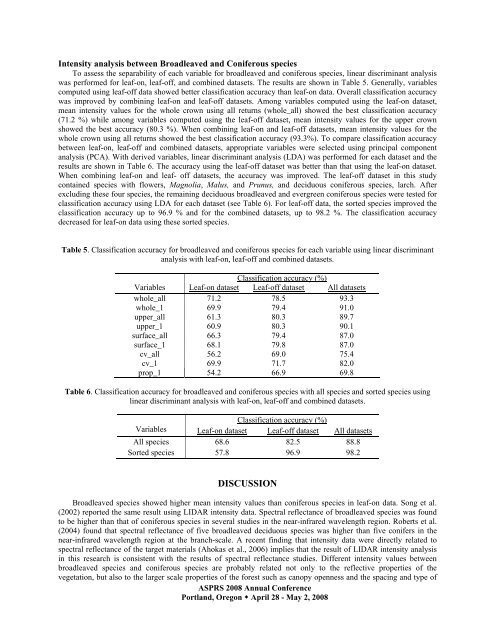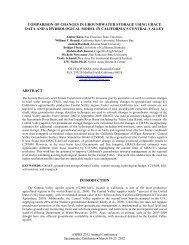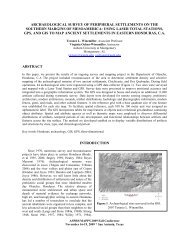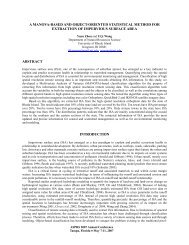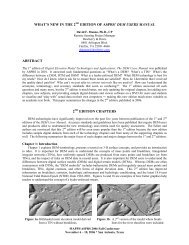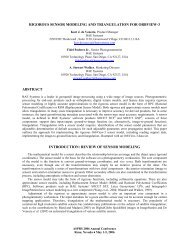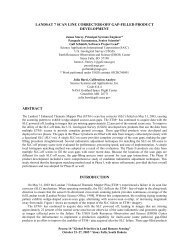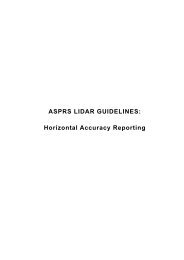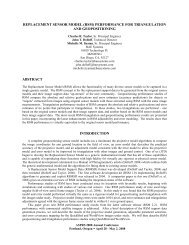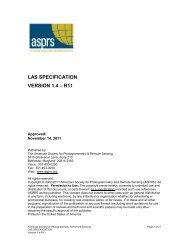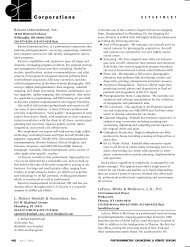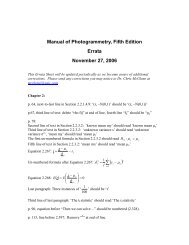Individual Tree Species Identification Using Lidar Intensity Data - asprs
Individual Tree Species Identification Using Lidar Intensity Data - asprs
Individual Tree Species Identification Using Lidar Intensity Data - asprs
Create successful ePaper yourself
Turn your PDF publications into a flip-book with our unique Google optimized e-Paper software.
<strong>Intensity</strong> analysis between Broadleaved and Coniferous species<br />
To assess the separability of each variable for broadleaved and coniferous species, linear discriminant analysis<br />
was performed for leaf-on, leaf-off, and combined datasets. The results are shown in Table 5. Generally, variables<br />
computed using leaf-off data showed better classification accuracy than leaf-on data. Overall classification accuracy<br />
was improved by combining leaf-on and leaf-off datasets. Among variables computed using the leaf-on dataset,<br />
mean intensity values for the whole crown using all returns (whole_all) showed the best classification accuracy<br />
(71.2 %) while among variables computed using the leaf-off dataset, mean intensity values for the upper crown<br />
showed the best accuracy (80.3 %). When combining leaf-on and leaf-off datasets, mean intensity values for the<br />
whole crown using all returns showed the best classification accuracy (93.3%). To compare classification accuracy<br />
between leaf-on, leaf-off and combined datasets, appropriate variables were selected using principal component<br />
analysis (PCA). With derived variables, linear discriminant analysis (LDA) was performed for each dataset and the<br />
results are shown in Table 6. The accuracy using the leaf-off dataset was better than that using the leaf-on dataset.<br />
When combining leaf-on and leaf- off datasets, the accuracy was improved. The leaf-off dataset in this study<br />
contained species with flowers, Magnolia, Malus, and Prunus, and deciduous coniferous species, larch. After<br />
excluding these four species, the remaining deciduous broadleaved and evergreen coniferous species were tested for<br />
classification accuracy using LDA for each dataset (see Table 6). For leaf-off data, the sorted species improved the<br />
classification accuracy up to 96.9 % and for the combined datasets, up to 98.2 %. The classification accuracy<br />
decreased for leaf-on data using these sorted species.<br />
Table 5. Classification accuracy for broadleaved and coniferous species for each variable using linear discriminant<br />
analysis with leaf-on, leaf-off and combined datasets.<br />
Classification accuracy (%)<br />
Variables Leaf-on dataset Leaf-off dataset All datasets<br />
whole_all 71.2 78.5 93.3<br />
whole_1 69.9 79.4 91.0<br />
upper_all 61.3 80.3 89.7<br />
upper_1 60.9 80.3 90.1<br />
surface_all 66.3 79.4 87.0<br />
surface_1 68.1 79.8 87.0<br />
cv_all 56.2 69.0 75.4<br />
cv_1 69.9 71.7 82.0<br />
prop_1 54.2 66.9 69.8<br />
Table 6. Classification accuracy for broadleaved and coniferous species with all species and sorted species using<br />
linear discriminant analysis with leaf-on, leaf-off and combined datasets.<br />
Classification accuracy (%)<br />
Variables Leaf-on dataset Leaf-off dataset All datasets<br />
All species 68.6 82.5 88.8<br />
Sorted species 57.8 96.9 98.2<br />
DISCUSSION<br />
Broadleaved species showed higher mean intensity values than coniferous species in leaf-on data. Song et al.<br />
(2002) reported the same result using LIDAR intensity data. Spectral reflectance of broadleaved species was found<br />
to be higher than that of coniferous species in several studies in the near-infrared wavelength region. Roberts et al.<br />
(2004) found that spectral reflectance of five broadleaved deciduous species was higher than five conifers in the<br />
near-infrared wavelength region at the branch-scale. A recent finding that intensity data were directly related to<br />
spectral reflectance of the target materials (Ahokas et al., 2006) implies that the result of LIDAR intensity analysis<br />
in this research is consistent with the results of spectral reflectance studies. Different intensity values between<br />
broadleaved species and coniferous species are probably related not only to the reflective properties of the<br />
vegetation, but also to the larger scale properties of the forest such as canopy openness and the spacing and type of<br />
ASPRS 2008 Annual Conference<br />
Portland, Oregon April 28 - May 2, 2008


